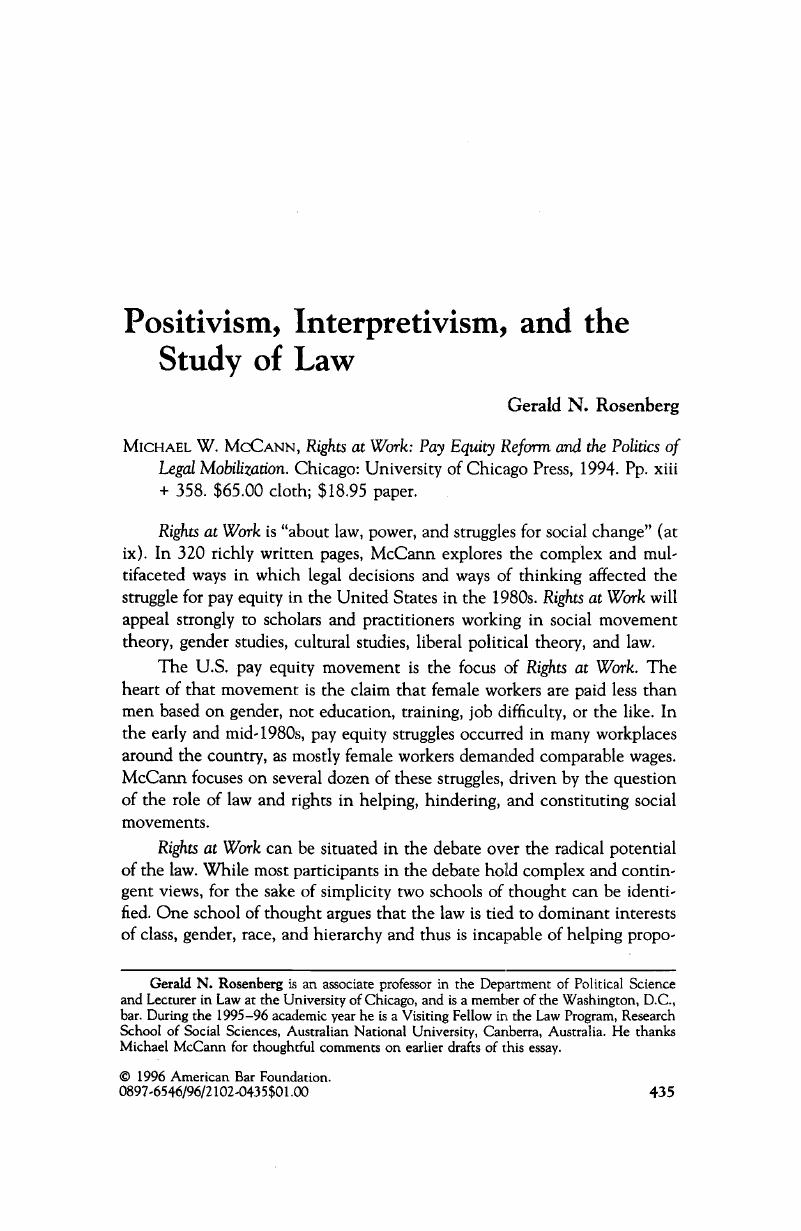Article contents
Positivism, Interpretivism, and the Study of Law
Published online by Cambridge University Press: 27 December 2018
Abstract

- Type
- Review Section Symposium
- Information
- Copyright
- Copyright © American Bar Foundation, 1996
References
1. Although positions in this debate are difficult to accurately characterize, proponents of such a view might include Joyce Appleby, “The American Heritage: The Heirs and the Disinherited,” 74 J. Am. Hist. 798 (1987); Alan Freeman, “Racism, Rights and the Quest for Equality of Opportunity: A Critical Legal Essay,” 23 Harv. C.R.–C.L. L. Rev. 295 (1988); Peter Gabel & Duncan Kennedy, “Roll Over Beethoven,” 36 Stan. L. Rev. 1 (1984); Morton J. Horwitz, “Rights,” 23 Harv. C.R.–C.L. L. Rev. 393 (1988); Mark Tushnet, “An Essay on Rights,” 62 Tex. L. Rev. 1363 (1984).Google Scholar
2. Although positions in this debate are also difficult to accurately characterize, proponents of such a view might include Amy Bartholomew & Alan Hunt, “What's Wrong with Rights?” 9 Law & Inequality 1 (1990); Mari J. Matsuda, “Looking to the Bottom: Critical Legal Studies and Reparations,” 22 Harv. C.R.–C.L. L. Rev. 323 (1987); Neal Milner, “The Denigration of Rights and the Persistence of Rights Talk: A Cultural Portrait,” 14 Law & Soc. Inquiry 631 (1989); Elizabeth M. Schneider, “The Dialectic of Rights and Politics: Perspectives from the Women's Movement,” 61 N.Y.U. L. Rev. 589 (1986); Ed Sparer, “Fundamental Human Rights, Legal Entitlements, and the Social Struggle: A Friendly Critique of the Critical Legal Studies Movement,” 36 Stan. L. Rev. 509 (1984); Stuart A. Scheingold, The Politics of Rights: Lawyers, Public Policy, and Political Change (New Haven, Conn.: Yale University Press, 1974); Patricia Williams, “Alchemical Notes: Reconstructing Ideals from Deconstructed Rights,” 22 Harv. C.R.–C.L. L. Rev. 401 (1987).Google Scholar
3. Michael W. McCann, Taking Reform Seriously: Perspectives on Public Interest Liberalism (Ithaca, N.Y.: Cornell University Press, 1986).Google Scholar
4. 452 U.S. 161 (1981).Google Scholar
5. McCann also carried out two other types of studies: “semi-intensive original” studies in which he interviewed “five to ten movement activists” and gained “significant access to organizational files”; and “limited original” studies where he interviewed “two to five activists” and gained access to “limited assorted materials from activist files” (at 45).Google Scholar
6. 452 U.S. 161 (1981).Google Scholar
7. 578 F. Supp. 846 (D. Wash. 1983).Google Scholar
8. 770 F.2d 1401 (9th Cir. 1985).Google Scholar
9. Fig. 3.4 (at 78). McCann does note, however, that there was “high legal consciousness” among the Yale clericals.Google Scholar
10. In McCann's defense, there is a reductio ad absurdum quality to this argument. One can always move to a smaller level of analysis in the name of greater depth and richness. Where does it stop? I see this as one of the weaknesses of interpretivist approaches.Google Scholar
11. Given the difficulty these two examples illustrate, it is a pity that Denver was only a “secondary study,” and that Yale was a “limited original study” (at 45, table 2.5, at 46).Google Scholar
12. For a particularly powerful argument for the radicalizing role of the civil rights movement on its participants, see Doug McAdam, Freedom Summer (New York: Oxford University Press, 1988).Google Scholar
13. This is the position taken by many members of the Critical Legal Studies Movement, as well as others. See, e.g., the sources cited in note 1.Google Scholar
14. Gerald N. Rosenberg, The Hollow Hope: Can Courts Bring about Social Change? 36 (Chicago: University of Chicago Press, 1991). This is the gist of my condition 4.Google Scholar
15. I tried to do something similar in The Hollow Hope. With civil rights, for example, I combined a positivist, top-down compliance analysis of the effects of Brown with a more interpretive approach, examining the thinking, beliefs, and attitudes of participants in the civil rights movement. While McCann (and others) find my approach too much on the positivism side, I find his approach too much on the interpretivist side. See Michael W. McCann, “Reform Litigation on Trial,” in “Symposium: The Supreme Court and Social Change,” 17 Law & Soc. Inquiry 715 (1992).CrossRefGoogle Scholar
- 28
- Cited by




